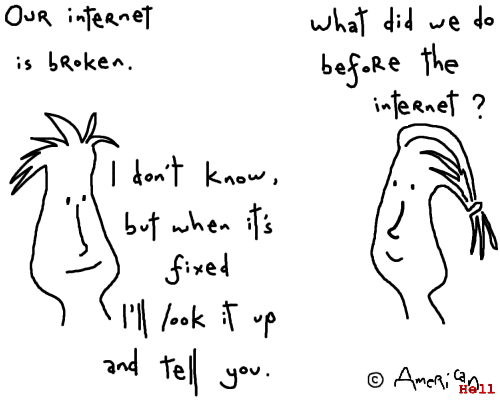I have written several articles on network communications on this blog site as well as on other sites, describing its evolution from serial communications connecting two machines, to the precursor of the Internet, called ARPANET, connecting mainframes and LANs at universities in the 1970s, and finally the arrival of the Internet in the 1980s, connecting the rest of us and all our devices to each other. All these networks were designed to connect static remote devices, computers sitting on desks hooked up by serial Ethernet cables to wired communications networks that soon spanned the globe. But that doesn’t describe the Internet of today, filled with smartphones, smart chips and billions of other communicating devices.
In 2006, a writer with the MIT Technology Review published an article entitled The Internet is Broken in which he described the incremental changes happening in Internet usage and the lack of response by network specialists to a growing number of problems. That same author this week posted a follow up article on the same subject arguing that the “creeping complexity” of the Internet in supporting mobile device technology will expose serious architectural and security problems unless something is done about it.
I’ll give you an example of the kinds of issues that I face with my Internet usage today. In my home I have a desktop computer running Windows 7. I also have a five-year old laptop running Windows XP, an Android tablet, an Android smartphone, and a WiFi enabled eReader. My daughter has her Windows7 laptop, an Android tablet, an iPod and a semi-smartphone good for email and short messaging. My wife has a Windows XP netbook and an Android smartphone. Currently our televisions are hooked up to satellite so no Internet capability as of yet. But soon I think.
We are all connected to the Internet through a single DSL line that is also our home voice line. The DSL is plugged into a WiFi-enabled modem that serves the house and a range extender that pushes the WiFi out to the end of the backyard.
All this connectivity and yet when I send an email to my wife sitting at a desk a few feet away from me it has to go out to the Internet and then come back into the house to get to her inbox. That just seems dumb to me.
Some documents and images that can be opened on my smartphone cannot be opened on my wife’s netbook but she can see them when she looks at the same attachment or document on her smartphone. And sometimes when I send an email from my smartphone through the Gmail application running on the device, I don’t see the sent email in my Gmail sent box on my desktop right away because I’m sending my message through the mobile 3G phone network. But if I send that Gmail from my smartphone while in the house my phone uses its WiFi connectivity and the email appears right away in the sent box. It’s even worse with my wife’s smartphone and netbook often requiring her to shut the computer off and restart for the sent mail to appear. She doesn’t use Gmail.
This latency issue where you have multiple communication protocols all using the same Internet pipe is a bottleneck and I can imagine as I along with so many other populate our houses with more smart devices just how congested communication through the Internet will become.
One organization that is engaging the issue is the National Science Foundation (NSF) which launched the Future Internet Architecture Project in the summer of 2010. In its introduction the NSF stated, “The continued success of the Internet…..is increasingly threatened by the ever-mounting sophistication of security attacks and by the lack of performance reliability of Internet services.” The project highlighted the following challenges:
- The importance of supporting and protecting content through better architecture and naming conventions.
- Supporting communications between mobile devices rather than fixed end points to reflect the changing demographic of Internet usage.
- Dealing with the Cloud with applications and data storage migrating from devices to cloud computing data centres as content repositories.
- Ensuring that the architecture of the Internet supports content creation from any device, any service, any program, with flexibility to anticipate any new communication protocol coming down the pipe in the foreseeable future.
- Developing multiple connect capability to allow a single Internet device like a mobile phone to seamlessly work with different types of services simultaneously including WiFi to 3G, 4G, LTE and anything beyond.
- Building device-to-device technologies that provide data transfer shortcuts that bypass the need for an infrastructure of net servers, an important capability for countries in the Developing World.
Without addressing each of these challenges an Internet of 15 billion things forecasted in 2015, and 50 billion possibly a decade later, will suffer from interruptions in service and network breakdowns.









